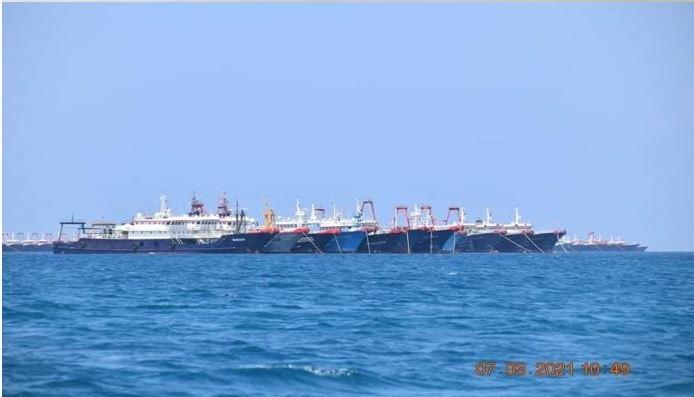The current international situation is somewhat similar to how it was before the Second World War in that there’s tension and conflict over the ownership of islands in the Indo-Pacific around China.
In 2020, the People’s Liberation Army (PLA), the official name for the CCP’s military, flew warplanes into Taiwan’s airspace 380 times (over one incursion a day). The trend continued into 2021. On March 26 alone, a total of 20 PLA military aircraft entered the southwestern airspace of Taiwan, setting a new record for 2021.
On March 23, the official Weibo (a Chinese social media site) account of the China Coast Guard announced that four Chinese Coast Guard (CCG) vessels cruised in the territorial waters of what they called China’s Diaoyu Islands. The islands are contested but are controlled by the Japanese, where they are known as the Senkaku islands.
This is the third time that the CCP has officially released such information in 2021.
Since March 7, more than 220 Chinese fishing boats have gathered on the Whitsun Reef (a disputed area between China and the Philippines). The CCP claimed that they were only temporarily sheltering from the harsh weather; the Philippines disputes this claim. On March 21, the Philippine Defense Secretary urged the—more than 200 Chinese ships—to leave immediately, and the Department of Foreign Affairs also issued a diplomatic protest to Beijing. On March 28, Philippine President Rodrigo Duterte had a talk with the Communist ambassador. On March 31, the U.S.-Philippines National Security Advisors discussed the CCP’s presence in the disputed waters of the South China Sea, and they both expressed their concern.
These activities of the CCP are not individual, isolated cases. They reflect the CCP’s view of the international situation and their ambition.
Strengthening Military Cooperation
On March 25, the United States and Taiwan signed a memorandum of coast guard cooperation to coordinate bilateral policies, joined by the Department of State’s Bureau of East Asian and Pacific Affairs Acting Assistant Secretary Sung Kim and USCG’s Director of International Affairs Ann Castiglione-Cataldo.After signing the agreement in Washington, Hsiao Bi-khim, the defacto Taiwanese ambassador to the United States, said in a statement, “It is our hope that with the new Coast Guard Working Group, both sides will forge a stronger partnership and jointly contribute even more to a free and open Indo-Pacific region.”
On March 23, Japan’s Okinawa Times reported that the Japan Ground Self-Defense Force planned to conduct emergency exercises on the Senkaku islands from September to November. This will be the largest exercise in the history of the Japanese Self-Defense Force. The last national exercise in Japan was 28 years ago. The report also noted the severity of Chinas activity around the islands as well as the severity of the security environment.
After the Biden administration was sworn in, the U.S. Secretary of State and the Defense Secretary visited Japan and South Korea. On April 2, national security advisor Jake Sullivan met his South Korean and Japanese counterparts to discuss security issues.
In mid-April, Japanese Prime Minister Yoshihide Suga will visit the United States. He will be the first foreign leader that President Biden will meet face-to-face. The Japanese newspaper Nikkei Asia broke the news that the two sides will issue a joint statement to “affirm the importance of stability in the Taiwan Strait.”
Australia and India Join Quad Meeting
The Quadrilateral Security Dialogue (Quad) meeting of the United States, Japan, India, and Australia was upgraded from ministerial level to summit level on March 12, and the military orientation became obvious.In Nov. 2020, Australia participated in the four-nation joint military exercise for the first time after a 13-year absence. On April 5, the Quad took part in the ‘La Pérouse’ joint naval exercise, organized by France from April 5–7 in the Bay of Bengal. Compared with previous years, the special feature of this military exercise was the official participation of India. Many Indian media reported that the joint military exercise aimed at countering the CCP’s “unilateral and expansionist actions in the region,” increasing influence in the Indo-Pacific region. After the exercise, the foreign ministers of India and Australia will also hold a trilateral meeting with the foreign ministers of France.
As the quadrilateral military cooperation develops, the bilateral military cooperation of the four countries has made some major substantive progress. For example, on March 31, Australia announced that it would work closely with the United States to begin building its own guided missiles to strengthen its defense capabilities. Washington’s top diplomat in Canberra also said, during an episode of the National Security Podcast, that the United States and Australia are discussing how they would respond to a range of military scenarios including an outbreak of war in the Taiwan Strait, and the “enormous respect” for how Australia had stood up to China’s “economic coercion” over the past year.
NATO Members Strengthen Indo-Pacific Military Presence
On March 23, NATO Secretary-General Jens Stoltenberg and visiting U.S. Secretary of State Blinken mentioned the CCP as a great global challenge in a press conference at NATO headquarters. In fact, as early as Dec. 4, 2019, when the NATO summit ended in London, China was mentioned for the first time in the London Declaration.Although, as far as the current situation is concerned, it is unlikely that NATO as a whole will have a direct military confrontation with the CCP, this does not rule out that some NATO member states are strengthening their military presence in the Indo-Pacific.
For example, on March 31, the Canadian Ministry of Defense said that the country’s HMCS Calgary had passed through the South China Sea from Brunei to Vietnam.
On March 3, German officials confirmed with Reuters that a German frigate would set sail for Asia in August and, on its return journey, the warship would not pass within the 12-nautical-mile limits China and rival states claim as territorial waters around contested features in the strategic waterway.
Britain is also scheduled to send its aircraft carrier HMS Queen Elizabeth to the waters later this year.
In short, military encirclement against the CCP is unfolding; the CCP’s wolf warrior diplomacy and expansionist policy are decisive factors in bringing it about.
In the face of this huge network of military cooperation (this article does not fully discuss it, for example, the U.S. military trends in Central Asia have not been discussed, and this has a direct deterrent effect on the CCP), the CCP’s power is really limited.
“China is [an] authoritarian country that doesn’t share our values. They will soon have the biggest economy in the world,” said Stoltenberg to the European Parliament’s committee on Foreign Affairs on March 15. “But together we represent 50 [percent] of the world’s GDP and 50 [percent] of the world’s military market. So if you’re concerned about the rise of China, the military and economic strength of China, that makes it even more important that we stand together, Europe and North America in NATO.”
However, one thing must be pointed out in particular: the CCP’s deceptive nature and its evil and madness are unprecedented in history. Former U.S. Secretary of State Pompeo said that the CCP’s threat surpasses the Soviet Union. For example, the former Soviet Union did sit down to negotiate with the United States and signed a series of arms control agreements. During the Cold War, the United States and the Soviet Union also formed the iron law of the cold war—neither side would directly engage in war because it could very well trigger a nuclear war. However, so far the CCP has never reached any arms control agreement with the United States, and even refused to participate in the China-U.S.-Russia Trilateral Arms Control Negotiations. The CCP has arbitrarily developed its military power, especially its strategic military power.
Any assessment of the CCP’s dangers cannot be overstated.
Although at present and in the foreseeable future, the CCP’s military strength is far inferior to that of the United States, its madness and evil is a deadly weapon, which is the most difficult to deal with.





